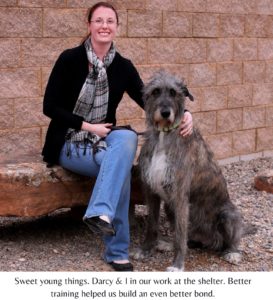or, Lessons Learned as Cross-Over Trainer
Last month, we looked at what positive reinforcement is, and why it isn’t used universally in dog training (though it should be). You may remember that:
- we live in a very punishment-centric culture, and
- this heavily influences what is considered normal in our relationships with dogs.
That was a great place to start, but it’s not the whole story. There’s more to why we hang onto punishment in our training.
Spoiler: you can want to train without punishment and STILL struggle let go of it.
I learned about why this is the hard way. Now, I share those experiences with you so you can be compassionate to your dog AND yourself in your own force-free training journey.
**********
If you happen to follow Quest on social media, you might have seen a post about my training journey with my first dog, Darcy.
Here’s the nitty gritty recap:
- A dog-obsessed kiddo, I first learned all about dog training that relied on punishment. Back then, there weren’t really alternatives. I used this training with our family dogs growing up.
- When I got a bit older, my curiosity led me to learn about different approaches from amazing writers like Patricia McConnell and Jean Donaldson. I adored their ideas, but I didn’t understand how to apply their concepts of force-free training in real life.

- So, when I got my very first dog—Darcy—I was confused and desperate to do right by her. Without other guidance, I fell back on punishment-based techniques. These techniques were also encouraged in the classes we attended. So, I used them, had a weaker connection to my dog, and still struggled with some of her behavior.
- I started working at an animal shelter, and the professional behaviorist there taught me effective force-free approaches. I moved away from punishment-based techniques, eventually becoming a trainer myself. It had huge impacts on Darcy’s behavior, yes, but also on our relationship.
Because of my experiences, I’m what’s referred to as a “cross-over trainer.” It means I “crossed-over” from teaching with corrections and coercion, to focusing on cooperation and force-free techniques.
Being a cross-over trainer has been a great gift, but it came with a steep learning curve. Having “seen the light” in regards to punishment, I looked back on some of the things I did with our family dogs and to my own beautiful Darcy with horror. Thoughts like “I can’t believe I ever did that!” and “I can’t believe she ever forgave me!” were frequently on repeat in those early days.
So, you can imagine my frustration with myself when, even years after deciding to move away from punishment-based training, I still found myself using punishment without meaning to. What was wrong with me!?
Well, what was “wrong” with me was simply that I was going through a struggle many of us face when we try to avoid using punishment. You see, we’re not in as much conscious control of ourselves as we think. There is more than just our internal desire to use or not use certain techniques influencing our actions. Like our dogs, we have a learning history and experience pressures in our environment, and that can influence the training tools we use.
As I sorted out what was going on, two lessons about what it means to choose force-free training over punishment for the human rose to the top:
Lesson 1: Using punishment feels more effective…even when it isn’t.
Let’s start with a story from my first day in the Karen Pryor Academy, a program which teaches trainers to effectively harness positive reinforcement teaching.
At the time I went through the course, I had actually been teaching “clicker training” classes for years. I had stopped intentionally training with punishing techniques long before and deeply believed punishment was not needed. Even so, I still sometimes fell back into bad habits, using mild punishment while teaching certain behaviors. Often, I did it without even realizing it. Ultimately, my KPA course gave me a better understanding of the power reinforcement, and that shook loose of some of the stickiest of my old punishment-focused training habits.
My first deep learning moment started when my mentor, Dani, walked over to check out our progress in a training task. She discovered a frustrated Ellen and an equally confused Darcy. We were supposed to be teaching our dogs to back up. But I was stuck.
“What’s not working?” Dani asked gently.
I showed her what we had been doing: to get Darcy to back up down a narrow lane of tables, I stood at the entrance facing her and leaned my body forward. Darcy responded to this body pressure by taking a step backward. I clicked that step and gave her a treat. But she never took more than a single step, and if we tried without me leaning into her, she didn’t step back at all. She clearly wasn’t understanding what I was clicking!
Patient and kind, Dani paused for a moment, trying to figure out how to explain this to me. “Let’s try it an new way, one where you don’t lean into her at all,” she suggested.
I sighed. I don’t think I rolled my eyes, but I might have. You see, I KNEW using body pressure to get Darcy to move worked. I KNEW it. I’d used this technique for years! It was the clicking and rewarding the step that wasn’t working, clearly. I just couldn’t figure out why!
But I kept my mouth shut and watched to see what Dani would do.
Dani invited Darcy to leave the lane of tables. Then she stepped into it herself. Standing on the far end, she placed a treat by her feet. Darcy eagerly trotted down the lane to eat the cookie, then, unsure how to turn around to leave, she took a step back. Dani clicked, and put another treat on the ground. Darcy ate it, thought for a minute, then took three steps back. Dani clicked, treated and repeated, and together they played this little game until Darcy was happily scooting back the entire length of the tables to get the next click.
I stood there, open mouthed and humbled. Dani explained that adding the body pressure to make Darcy back up probably confused and distracted her. After all, it was a mild form of positive punishment, and we know how applying punishment can cause the learner to struggle. It made it hard for her to understand what I was actually asking for. Most importantly, there was no need. It was easier, and more efficient, to teach the behavior without it.
I had been so absolutely sure that adding the body pressure worked. I had been sure despite it NOT working right in front of me. Why? Well, this is one of the most critical lessons for us to understand about using punishment.
I was so very sure my punishment-based technique worked because I had a learning history of using it. And using punishment is reinforcing to the punisher.
Huh?
In a nutshell: we get reinforced internally when we punish others. Punishing something we don’t like feels active and empowering. It allows us to act out our own emotions of fear, frustration, or anger. And, adding punishment often causes an immediate, observable change in the behavior of others…even if that change doesn’t last long. But we see the immediate change and our brain holds on to that.
And because applying punishment fulfills a few internal needs of ours, it’s actually reinforcing!
That means we will try hard to keep doing it, just like we will repeat anything else our brains find reinforcing. With punishment, this means we’ll insist it’s working…even when it’s not. We’ll keep collar popping the dog who barks at other dogs, even though he’ll still bark at the next dog he sees and we’ll have to punish again. We’ll walk a dog on a prong collar over and over and swear it’s teaching her not to pull, even when she pulls whenever the collar is off.
The reinforcing power of punishment on the punisher is so strong we tell ourselves a story about its effectiveness in order to keep using it. We convince ourselves that it works better, or faster, or more efficiently than positive reinforcement. Despite all the studies that actually say it slows down and interferes with learning. Despite seeing other trainers get the same or better results without it.
I am convinced this is the primary reason many trainers and pet guardians swear by the effectiveness of punishment and struggle to let go of it. We, too, are subject to our learning histories.
Just know that if you have used punishment in training, you have been reinforced for doing so, and that will mean you might have a harder time stepping away from techniques that seemed to “always work” in the past. It takes seeing different outcomes over and over before your brain will stop believing the story it’s telling itself.
Lesson 2: Shame increases your desire to punish your dog
“Who’s walking who?”

Image © by D-Keine via Canva
This has got to be, beyond a doubt, my least favorite phrase thrown at dog walkers by the peanut gallery. I’ve heard it plenty of times myself. Take a very large dog (like my Irish Wolfhounds) and a fairly normal-sized woman (like me), add even a tiny amount of tension in the leash, and you will get some dude shouting this across a room. It’s like they wait for just that moment to ambush you.
Early into my cross-over journey, I noticed weird patterns in both when I heard this comment and how I responded. And they were…enlightening.
The when: it happened anytime there was tension in my leash in a public space. That makes sense…except…
I had taught Darcy a loose leash walk as my first experiment with force-free training. It had worked wonderfully! She never pulled much afterward, and she walked calmly down streets and store aisle with very little effort on my part. It wasn’t a strict heel, but a relaxed dance between us both to keep the leash slack.
But every once and a while, she would pull toward something: a particularly good smell, or a dropped bit of food. I could usually ask her to return and refocus without much fuss. But early on, it felt like every time it happened, someone was there to comment. Sometimes the question came in a gentle, playful “yeah, I’ve been there” kind of way. Sometimes it was hurled at us with a sneer, the speaker clearly eager to share they thought I had no control over my giant dog.
What really struck me, though, was realizing I hadn’t heard that phrase back when I walked Darcy on a prong collar. Even though, on her prong collar, she actually WAS pulling most of the time! What was going on?
I also noticed something happening to me when the infamous “Who’s walking who?” came my way. My throat tightened up. My hands involuntarily clenched the leash. I would start to pull back against Darcy and, in the worst moments, I’d unthinkingly give her a pop on her collar, just like I would have done back in the bad-old-days of corrections training.
It took years for me to work past these involuntary hand spasms. Struggling through it made me aware of how much time we spend judging others for perceived failings in their dog training. And if you are judged by others as the owner of a “bad dog,” it really encourages you to punish the dog.
Perceiving judgement in others can bring on the feeling of shame. If you’ve read any of the amazing books by author Brené Brown (and if you haven’t, I HIGHLY recommend you do; my personal favorite is Daring Greatly), then you know that the emotion of shame is a powerful one that can push us into all sorts of harmful behaviors. Experiencing shame feels very dangerous to our brains and bodies.
So, a shaming experience is highly punishing. Even if it’s not intended to be. And someone making a snarky comment about your dog (even in jest) is shaming.
This is just one example of how we quietly and venomously shame each other as dog guardians. If you go out and about with your dog, you often receive consistent, mild punishment in the form of subtle shaming from others about that dog’s behavior, even when it is actually not that bad. (This is also not at all unique to being a pet parent. We do it to human parents, especially mothers, all the time.)
Then, something insidious happens during those moments of judgement: if you apply punishment to your dog, the shaming stops. I never got snarky comments walking Darcy on a prong collar. The underlying cultural belief is that if you are punishing “bad” behavior, then you are doing good and do not need to be judged.
The result? Very often people increase the punishment of their dogs when they are watched by others. Many of us punish our dogs more when a guest is over, or in a class, or when out in public. Our punishments get bigger and more demonstrative. I see this often in fellow trainers, who’s become harsher if their dog does not demonstrate a behavior, or “acts up” in a public space.
We do all this in an effort to escape punishment ourselves, punishment applied by other humans.
In the words of a favorite 90s song, isn’t it ironic?
(Side rant: the correct answer to “Who’s walking who?” No one. I am walking with my dog. Sometimes I stop to look at do-das…sometimes they stop to sniff. Why we gotta make it into something it’s not?)
**********
So, we get reinforced internally for punishing others…and we get punished by others for not punishing? No wonder training with punishment is dug into American dog culture like a diseased tick!
But there is light at the end of this tunnel, I believe. We can, as a culture, push past these old, out-dated beliefs about what type of training is required to teach our furry best friends.
I have that hope because I’ve lived it: I went from learning nothing but coercive, punishment-dependent training to move into a communication-based, reward-focused way of living with my dogs. But to make this transition successfully, we’ve got to start by understanding why giving up those old ways can feel so hard on this end of the leash.
Next month, we’ll step away from all this serious talk about punishment with a lighter topic. If you’re eager for the third installment, stay tuned for the November post, when I pick this topic back up to answer a burning question for many new force-free training guardians: do “positive reinforcement” trainers ever punish their dogs?

